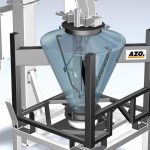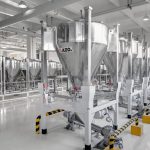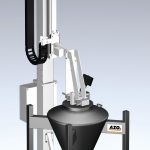Thanks to its container cleaning system, Azo makes dry and effective cleaning possible for all types and sizes of rotationally symmetrical hoppers without using water and chemicals. Circular containers are purged with compressed air quickly and carefully and are soon ready for use again. Handling and subsequent cleaning are either manual or partially automated, depending on user requirements. The following illustrates further advantages of the container cleaning station.
Dry cleaning of containers using compressed air
Spotlessly clean from the inside
Thanks to its container cleaning system, Azo makes dry and effective cleaning possible for all types and sizes of rotationally symmetrical hoppers without using water and chemicals. Circular containers are purged with compressed air quickly and carefully and are soon ready for use again. Handling and subsequent cleaning are either manual or partially automated, depending on user requirements. The following illustrates further advantages of the container cleaning station.
Azo has developed a system for dry cleaning of containers on behalf of a global company in the chemical industry. It forms part of a container line for extremely precise composition of powdered raw materials. All the components needed in the formulation are automatically dosed and weighed into a container in an Azo Componenter. To do so, the container, which is on mobile scales, is driven in turn to each individual metering point and docked there. Once all the components are in the container, this is discharged into the mixer. After this, the container either remains in the line or, if necessary, it is cleaned in the cleaning station using compressed air. It can then be returned into production.
Environmentally friendly
The cleaning station has been designed in such a way that containers contaminated on the inside with product residue and dust can be cleaned automatically. It can be used both for cleaning large and small hoppers. This means that restricted inlets on compact containers do not pose an obstacle, as the slimline cleaning unit only opens up once it is inside the container. The cleaning station can thus be designed to be adaptable for virtually any geometrical shape of rotationally symmetrical hoppers.
Water is frequently used for cleaning containers. This necessitates expensive washing chambers and drier units, which need to be installed in separate parts of the building. Therefore wet cleaning results in the containers being out of production for a longer time in order to carry out the cleaning and subsequent drying processes. In most cases, however, dry cleaning the containers is totally sufficient to remove any product residue reliably. This type of cleaning provides quite a few advantages if contrasted with wet cleaning. Since no water is used, the station can be installed directly in production. The outcome is shorter transport distances for hoppers and in addition there is no need for time-consuming drying processes. A further advantage of dry cleaning is that no wastewater is produced that would then have to be treated at great expense.
Collapsible and robust
The cleaning unit is attached to a vertical pillar with a cantilever bracket and can be moved in a vertical line with a linear drive. The cleaning unit consists of two arms where the cleaning jets are attached. These arms are folded together tightly as the cleaning unit is inserted into the container and they do not open out until fully inserted in the container. Once unfolded, the unit is rotated during the cleaning cycle via a pneumatic rotary drive. This enables it to reach all points on the inside of the container and to purge them with compressed air. The nozzles have a central supply of cleaning air via pneumatic hoses that run in a flexible energy supply chain.
The container that is being cleaned, and which is usually fitted with a manually operated outlet valve, is deposited by a lifting truck onto the station for cleaning or is conveyed to the station automatically. Centring corners make it easier to position the container. A dust-tight connection is generated between the container outlet and the suction hopper with the aid of the patented docking collar. An exhaust for suction is connected to this hopper via a central filter station, which extracts product residue and dust particles that accumulate during the cleaning cycle. The container’s outlet valve can be opened and closed manually or automatically, depending on the model.
Ranging from manual to fully automatic
If a container needs to be cleaned as a result of a changeover in products or due to a set cleaning interval, it is removed from production and placed on the cleaning station. The station is now in its starting position, i.e. the linear drive with the attached cleaning unit is in the upper end position and the rotary drive is in the starting position. The supply of cleaning air and suction are switched off.
The container can be deposited manually with a fork or pallet truck; alternatively it can also be moved onto the station using a roller or chain conveyor. It is possible to implement various levels of automation. The container outlet is connected to the docking collar on the suction hopper either by lowering the container or by raising the suction hopper, depending on the model.
The containers are usually sealed with a cover to prevent dust from escaping accidentally. Just as when the container is deposited, there are various levels of automation available for opening the container cover. From straightforward visual inspection and manual removal of the cover through to automatic inspection and opening of the cover.
Simple and effective
Once the container outlet valve is open, the cleaning unit is driven into the container in the lower end position using two-handed operation. The following sequences run automatically in accordance with the specified parameters. Once the cleaning unit has been inserted into the container, the arms with the cleaning jets unfold and suction is switched on. When planning the system, it is important to ensure that the suction power is higher than that used to inject the air for cleaning. The slight negative pressure in the container helps to securely prevent dust from escaping. As soon as cleaning air is admitted, the cleaning unit is switched to a rotary movement. The drive allows rotation through 360° and then returns to the starting position. Product residue and particles of solid matter adhering to the container are purged from the walls, agitated and extracted below. Air and product residue are passed through the open container valve to the central filter. The cleaning cycle varies in length depending on the level of contamination.
Once cleaning has finished, the supply of air to the cleaning jets stops and the arms are folded up. Now the cleaning unit can be moved out of the container and suction stopped. The machine operator closes the container outlet valve and locks the container cover in place so that they can then remove the container from the station. The clean container can now be immediately returned back into production.
Hall 1, Booth 356
www.cpp-net.com search: cpp0116azo
Frank Pahl
Frank Pahl
Director Development,
Azo
Michaela Volk
Michaela Volk
Marketing,
Azo
Share:









